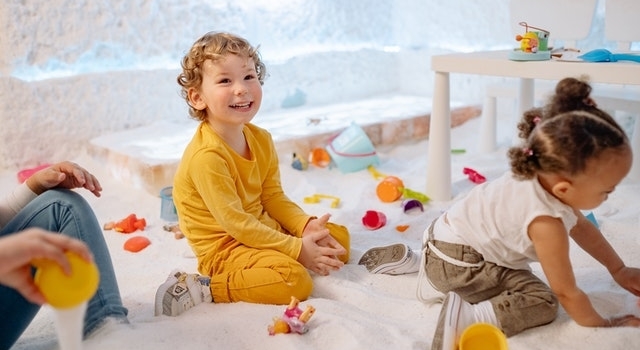Autism can make communication and understanding difficult, but visual supports can help.
Autism Spectrum Disorder (ASD) is a group of developmental conditions that can cause social, behavioral and emotional issues.
ASD can also create problems in communication that can result in frustration and anxiety for both the child with autism and their parents, who are trying to understand and care for them.
Visual supports are an innovative and practical way to facilitate communication by converting ideas and instructions to easy to use and understand visual aids.
What are visual supports?
Visual supports are simply pictures or other visual items that are used to communicate ideas or instructions to a person who has difficulty using or understanding verbal communication.
Visual supports can make life a lot easier for people who live with the anxieties and difficulties associated with ASD.
These supports can be anything from a photo, illustration or colored square to short videos or miniatures of familiar people or objects.
Here are some of the areas where these supports are most helpful:
1. Understanding social cues
People with ASD do not always understand social cues that many neuro-typical people take for granted.
They may have difficulty understanding how to start conversations, how to respond when others approach them socially or how to alter behavior based on unspoken cues such as body language or tone of voice.
Certain visual supports can help teach a person with ASD ways to interact with others and eventually allow them the opportunity to practice these skills on their own.
2. Processing and following verbal instructions
Autism also makes it difficult to understand and follow verbally-communicated instructions.
A person with ASD may find it challenging to process these instructions, creating frustration and anxiety for themselves and others when communication breaks down.
Visual supports, such as written or illustrated timelines, can help solidify concepts, clarify expectations and serve as something tangible to refer back to when steps might be forgotten or not fully understood.
These supports can also help a person with ASD work through complicated processes step-by-step so that they can accomplish these tasks independently or with minimal assistance.
3. Working through routines
Some people with ASD may get anxious or act out when they are faced with unfamiliar situations or a change in their routine.
Visual supports can help calm this anxiety by helping them know what comes next and what they should expect from where they are and what they are doing.
These supports can help them pay better attention to the details of a routine and cope with changes more easily and comfortably.
SEE RELATED: How Does Vision Therapy Help Children with Autism?
If your child has ASD, schedule an eye exam with an eye doctor near you to give them the best support possible.
Common examples of visual supports
Here are some examples of common visual supports used to help people with ASD navigate and understand the world more easily:
First-Then board
A First-Then board is a visual tool designed to motivate the person using it. In practice, it is a representation of something that a person with ASD needs to do “first” so they can “then” do something they want to do.
When using a First-Then board, parents and teachers can attach clear and concise verbal instructions to the pictures or text on the “First” side of the board, and clearly attach that action to the reward on the “Then” side of the board. For example, “First, shoes on. Then, play at the park.” This will keep the child on track without overwhelming them with too much information, which can trigger anxiety.
This is helpful in allowing parents and caregivers to clearly communicate simple actions that they want done before more enjoyable activities can be engaged in, and it allows the child to clearly communicate what they would like to do thereafter.
A First-Then board can also be a good way to introduce new experiences and places, by attaching a reward to them.
Visual schedule
A visual schedule is a visual representation of a sequence of events throughout a day or within a certain event, task or activity.
It can be especially helpful in breaking down an otherwise complicated task into manageable pieces, thereby assisting in the learning and proper execution of these tasks. It can also be helpful in reducing anxiety around transitions from activity to activity throughout the day.
A visual schedule can include drawings, photos, text or whatever else is helpful to increase understanding of the schedule and reduce worry around it. It can be portable, as in laminated pages or photos in a binder, or it can be affixed to a permanent spot, like a wall or refrigerator.
When the visual schedule is first introduced, a parent or teacher may need to give the child a verbal cue when activities begin or at transitions between activities or steps within an activity. As the child becomes more familiar with the schedule, parents and caregivers should encourage increasingly independent use.
Visual parameters
Visual parameters are supports used to set clear boundaries around activities, items or spaces. They help to clearly communicate what others expect in terms of behavior.
These can be helpful to communicate limits on certain activities that might otherwise seem unclear.
An illustrated stop sign can communicate the physical limits of a play space, a picture of 2 scoops of ice cream can communicate the limits on snacks during the day, and placing a “not available” sign on toys can show when it’s not time to play with those items.
LEARN MORE: Vision for Special Needs
Does your child have ASD? Schedule an eye exam with an eye doctor near you, as visual support may be the answer you have been looking for.
Visual supports can make life a lot easier for people who live with the anxieties and difficulties associated with ASD.


